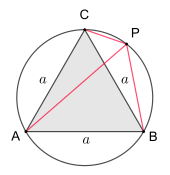Van Schooten's theorem
On lines connecting the vertices of an equilateral triangle to a point on its circumcircle

Van Schooten's theorem, named after the Dutch mathematician Frans van Schooten, describes a property of equilateral triangles. It states:
- For an equilateral triangle with a point on its circumcircle the length of longest of the three line segments connecting with the vertices of the triangle equals the sum of the lengths of the other two.
The theorem is a consequence of Ptolemy's theorem for concyclic quadrilaterals. Let be the side length of the equilateral triangle and the longest line segment. The triangle's vertices together with form a concyclic quadrilateral and hence Ptolemy's theorem yields:
Dividing the last equation by delivers Van Schooten's theorem.
References
- Claudi Alsina, Roger B. Nelsen: Charming Proofs: A Journey Into Elegant Mathematics. MAA, 2010, ISBN 9780883853481, pp. 102–103
- Doug French: Teaching and Learning Geometry. Bloomsbury Publishing, 2004, ISBN 9780826434173 , pp. 62–64
- Raymond Viglione: Proof Without Words: van Schooten′s Theorem. Mathematics Magazine, Vol. 89, No. 2 (April 2016), p. 132
- Jozsef Sandor: On the Geometry of Equilateral Triangles. Forum Geometricorum, Volume 5 (2005), pp. 107–117
External links

Wikimedia Commons has media related to Van Schooten's theorem.
- Van Schooten's theorem at cut-the-knot.org






![{\displaystyle {\begin{aligned}&|BC|\cdot |PA|=|AC|\cdot |PB|+|AB|\cdot |PC|\\[6pt]\Longleftrightarrow &a\cdot |PA|=a\cdot |PB|+a\cdot |PC|\end{aligned}}}](https://wikimedia.org/api/rest_v1/media/math/render/svg/fbdf50a5f1db26f37b9526f4120dc4144dd2e075)











